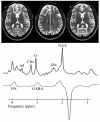Polysubstance and alcohol dependence: unique abnormalities of magnetic resonance-derived brain metabolite levels
- PMID: 23122599
- PMCID: PMC3624044
- DOI: 10.1016/j.drugalcdep.2012.10.004
Polysubstance and alcohol dependence: unique abnormalities of magnetic resonance-derived brain metabolite levels
Abstract
Background: Although comorbid substance misuse is common in alcohol dependence, and polysubstance abusers (PSU) represent the largest group of individuals seeking treatment for drug abuse today, we know little about potential brain abnormalities in this population. Brain magnetic resonance spectroscopy studies of mono-substance use disorders (e.g., alcohol or cocaine) reveal abnormal levels of cortical metabolites (reflecting neuronal integrity, cell membrane turnover/synthesis, cellular bioenergetics, gliosis) and altered concentrations of glutamate and γ-aminobutyric acid (GABA). The concurrent misuse of several substances may have unique and different effects on brain biology and function compared to any mono-substance misuse.
Methods: High field brain magnetic resonance spectroscopy at 4 T and neurocognitive testing were performed at one month of abstinence in 40 alcohol dependent individuals (ALC), 28 alcohol dependent PSU and 16 drug-free controls. Absolute metabolite concentrations were calculated in anterior cingulate (ACC), parieto-occipital (POC) and dorso-lateral prefrontal cortices (DLPFC).
Results: Compared to ALC, PSU demonstrated significant metabolic abnormalities in the DLPFC and strong trends to lower GABA in the ACC. Metabolite levels in ALC and light drinking controls were statistically equivalent. Within PSU, lower DLPFC GABA levels are related to greater cocaine consumption. Several cortical metabolite concentrations were associated with cognitive performance.
Conclusions: While metabolite concentrations in ALC at one month of abstinence were largely normal, PSU showed persistent and functionally significant metabolic abnormalities, primarily in the DLPFC. Our results point to specific metabolic deficits as biomarkers in polysubstance misuse and as targets for pharmacological and behavioral PSU-specific treatment.
Copyright © 2012 Elsevier Ireland Ltd. All rights reserved.
Figures


Similar articles
-
Metabolic abnormalities in lobar and subcortical brain regions of abstinent polysubstance users: magnetic resonance spectroscopic imaging.Alcohol Alcohol. 2013 Sep-Oct;48(5):543-51. doi: 10.1093/alcalc/agt056. Epub 2013 Jun 23. Alcohol Alcohol. 2013. PMID: 23797281 Free PMC article. Clinical Trial.
-
Glutamate, GABA, and other cortical metabolite concentrations during early abstinence from alcohol and their associations with neurocognitive changes.Drug Alcohol Depend. 2012 Sep 1;125(1-2):27-36. doi: 10.1016/j.drugalcdep.2012.03.012. Epub 2012 Apr 12. Drug Alcohol Depend. 2012. PMID: 22503310 Free PMC article.
-
Structural brain differences in alcohol-dependent individuals with and without comorbid substance dependence.Drug Alcohol Depend. 2014 Nov 1;144:170-7. doi: 10.1016/j.drugalcdep.2014.09.010. Epub 2014 Sep 19. Drug Alcohol Depend. 2014. PMID: 25263262 Free PMC article.
-
The importance of considering polysubstance use: lessons from cocaine research.Drug Alcohol Depend. 2018 Nov 1;192:16-28. doi: 10.1016/j.drugalcdep.2018.07.025. Epub 2018 Sep 1. Drug Alcohol Depend. 2018. PMID: 30195242 Free PMC article. Review.
-
Functional magnetic resonance and spectroscopy in drug and substance abuse.Top Magn Reson Imaging. 2005 Jun;16(3):247-51. doi: 10.1097/01.rmr.0000194048.43739.d4. Top Magn Reson Imaging. 2005. PMID: 16340649 Review.
Cited by
-
Effects of fat on MR-measured metabolite signal strengths: implications for in vivo MRS studies of the human brain.NMR Biomed. 2013 Dec;26(12):1768-74. doi: 10.1002/nbm.3016. Epub 2013 Sep 24. NMR Biomed. 2013. PMID: 24115006 Free PMC article.
-
GABAergic contributions to alcohol responsivity during adolescence: insights from preclinical and clinical studies.Pharmacol Ther. 2014 Aug;143(2):197-216. doi: 10.1016/j.pharmthera.2014.03.001. Epub 2014 Mar 11. Pharmacol Ther. 2014. PMID: 24631274 Free PMC article. Review.
-
Brain proton magnetic resonance spectroscopy of alcohol use disorders.Handb Clin Neurol. 2014;125:313-37. doi: 10.1016/B978-0-444-62619-6.00019-7. Handb Clin Neurol. 2014. PMID: 25307583 Free PMC article. Review.
-
Imaging neuroinflammation in individuals with substance use disorders.J Clin Invest. 2024 Jun 3;134(11):e172884. doi: 10.1172/JCI172884. J Clin Invest. 2024. PMID: 38828729 Free PMC article. Review.
-
Brain perfusion in polysubstance users: relationship to substance and tobacco use, cognition, and self-regulation.Drug Alcohol Depend. 2015 May 1;150:120-8. doi: 10.1016/j.drugalcdep.2015.02.022. Epub 2015 Feb 26. Drug Alcohol Depend. 2015. PMID: 25772434 Free PMC article.
References
-
- Abi-Saab D, Beauvais J, Mehm J, Brody M, Gottschalk C, Kosten TR. The effect of alcohol on the neuropsychological functioning of recently abstinent cocaine-dependent subjects. Am. J. Addict. 2005;14:166–178. - PubMed
-
- Association AP. Diagnostic and Statistical Manual of Mental Disorders. American Psychiatric Association; Washington, D.C: 1994.
-
- Baler RD, Volkow ND. Drug addiction: the neurobiology of disrupted self-control. Trends Mol. Med. 2006;12:559–566. - PubMed
-
- Beck AT. Depression Inventory. Center for Cognitive Therapy; Philadelphia: 1978.
-
- Benedict R. Brief Visuospatial Memory Test - Revised: Professional Manual. Psychological Assessment Resources, Inc.; Odessa, FL: 1997.
Publication types
MeSH terms
Grants and funding
LinkOut - more resources
Full Text Sources
Other Literature Sources
Medical

